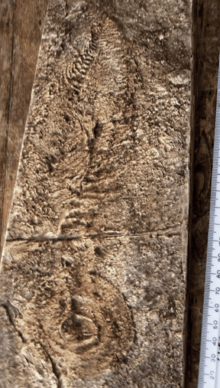Ediacaran type preservation
Ediacaran type preservation relates to the dominant preservational mode in the Ediacaran period, where Ediacaran organisms were preserved as casts on the surface of microbial mats.
Exceptional preservation

All but the smallest fraction of the fossil record consists of the robust skeletal matter of decayed corpses. Hence, since Ediacaran biota had soft bodies and no skeletons, their abundant preservation is surprising. The absence of burrowing creatures living in the sediments undoubtedly helped;[1] since after the evolution of these organisms in the Cambrian, soft-bodied impressions were usually disturbed before they could fossilize.
Microbial mats
Microbial mats are areas of sediment stabilised by the presence of colonies of microbes, which secrete sticky fluids or otherwise bind the sediment particles. They appear to migrate upwards when covered by a thin layer of sediment, but this is an illusion caused by the colony's growth; individuals do not, themselves, move. If too thick a layer of sediment is deposited before they can grow or reproduce through it, parts of the colony will die, leaving behind fossils with a characteristically wrinkled "elephant skin" texture.[2] Most Ediacaran strata with the "elephant skin" texture characteristic of microbial mats contain fossils, and Ediacaran fossils are almost never found in beds that do not contain these microbial mats. Although microbial mats were once widespread, the evolution of grazing organisms in the Cambrian vastly reduced their numbers,[3] and these communities are now limited to inhospitable refugia where predators cannot survive long enough to eat them.
Fossilisation
The preservation of these fossils is one of their great fascinations to science. As soft-bodied organisms, they would normally not fossilise. Unlike later soft-bodied fossil biota (such as the Burgess Shale, or Solnhofen Limestone) the Ediacara biota is not found in a restricted environment subject to unusual local conditions: they were a global phenomenon. The processes that were operating must have been systemic and worldwide. There was something very different about the Ediacaran Period that permitted these delicate creatures to be left behind. It is thought that the fossils were preserved by virtue of rapid covering by ash or sand, trapping them against the mud or microbial mats on which they lived.[4] Ash beds provide more detail, and can readily be precisely dated to the nearest million years or better by means of radiometric dating.[5] However, it is more common to find Ediacaran fossils under sandy beds deposited by storms or high-energy, bottom-scraping ocean currents known as turbidites.[4] Soft-bodied organisms today almost never fossilise during such events, but the presence of widespread microbial mats probably aided preservation by stabilising their impressions in the sediment below.[6]
What is preserved?
The rate of cementation of the overlying substrate, relative to the rate of decomposition of the organism, determines whether the top or bottom surface of an organism is preserved. Most disc-shaped fossils decomposed before the overlying sediment was cemented, and the ash or sand slumped in to fill the void, leaving a cast of the underside of the organism.
Conversely, quilted fossils tend to decompose after the cementation of the overlying sediment; hence their upper surfaces are preserved. Their more resistant nature is reflected in the fact that in rare occasions, quilted fossils are found within storm beds, the high-energy sedimentation not having destroyed them as it would have the less-resistant discs. Further, in some cases, the bacterial precipitation of minerals formed a "death mask", creating a mould of the organism.[7]
Types of preservation
Four different preservational modes are known:[8] [9][10]
- Flinders-style: Such as found in Ediacara, the fossils are preserved on the underside of usually coarse grained sandstone beds;
- Conception-style: The fossils are preserved as an impression in an overlying bed of freshly fallen volcanic ash, often in exquisitely fine detail;
- Nama-style: Fossils are preserved in three dimensions, within fine-grained beds that were deposited in single storm or mudflow events;
- Fermeuse-style: Known from deep water only. Only trace fossils and imprints of holdfast structures are preserved; the soft tissue itself has decayed (although the sediment within the holdfasts remains).
References
- ↑ Stanley, S.M. (1973). "An Ecological Theory for the Sudden Origin of Multicellular Life in the Late Precambrian". Proc. Nat. Acad. Sci. U.S.A. 70 (5): 1486–1489. Bibcode:1973PNAS...70.1486S. doi:10.1073/pnas.70.5.1486. PMC 433525. PMID 16592084.
- ↑ Runnegar, B.N.; Fedonkin, M.A. (1992). "Proterozoic metazoan body fossils". In Schopf, W.J.; Klein, C. The Proterozoic biosphere. The Proterozoic Biosphere, a Multidisciplinary Study: Cambridge University Press, New York (Cambridge University Press). pp. 369–388. ISBN 978-0-521-36615-1. OCLC 23583672 26310475.
- ↑ Burzin, M.B.; Debrenne, F.; Zhuravlev, A.Y. (2001). "Evolution of shallow-water level-bottom communities". In Zhuravlev, A.Y.; Riding, R. The Ecology of the Cambrian Radiation. Columbia University Press, New York. pp. 216–237. ISBN 0-231-50516-7. OCLC 51852000. Retrieved 2007-05-06.
- 1 2 Narbonne, Guy M. (1998). "The Ediacara biota: A terminal Neoproterozoic experiment in the evolution of life" (PDF). GSA 8 (2): 1–6. ISSN 1052-5173. Retrieved 2007-03-08.
- ↑ Bowring, S.A.; Martin, M.W. (2001). "Calibration of the Fossil Record". In Briggs & Crowther. Palæobiology II: A synthesis. Blackwell publishing group. ISBN 978-0-632-05149-6. OCLC 51481754 55536116. Retrieved 2007-06-21.
- ↑ Gehling, J. G. (1987). "Earliest known echinoderm — a new Ediacaran fossil from the Pound Subgroup of South Australia". Alcheringa: an Australasian Journal of Palaeontology 11 (4): 337–345. doi:10.1080/03115518708619143.
- ↑ Gehling, J. G. (1999). "Microbial Mats in Terminal Proterozoic Siliciclastics: Ediacaran Death Masks". PALAIOS 14 (1): 40–57. doi:10.2307/3515360. JSTOR 3515360.
- ↑ Summarized in Laflamme 2010; detailed in Narbonne 2005
- ↑ Laflamme, M.; Schiffbauer, J. D.; Narbonne, G. M.; Briggs, D. E. G. (2010). "Microbial biofilms and the preservation of the Ediacara biota". Lethaia: no. doi:10.1111/j.1502-3931.2010.00235.x.
- ↑ Narbonne, G. M. (2005). "THE EDIACARA BIOTA: Neoproterozoic Origin of Animals and Their Ecosystems". Annual Review of Earth and Planetary Sciences 33: 421–442. Bibcode:2005AREPS..33..421N. doi:10.1146/annurev.earth.33.092203.122519.
| ||||||||||||
